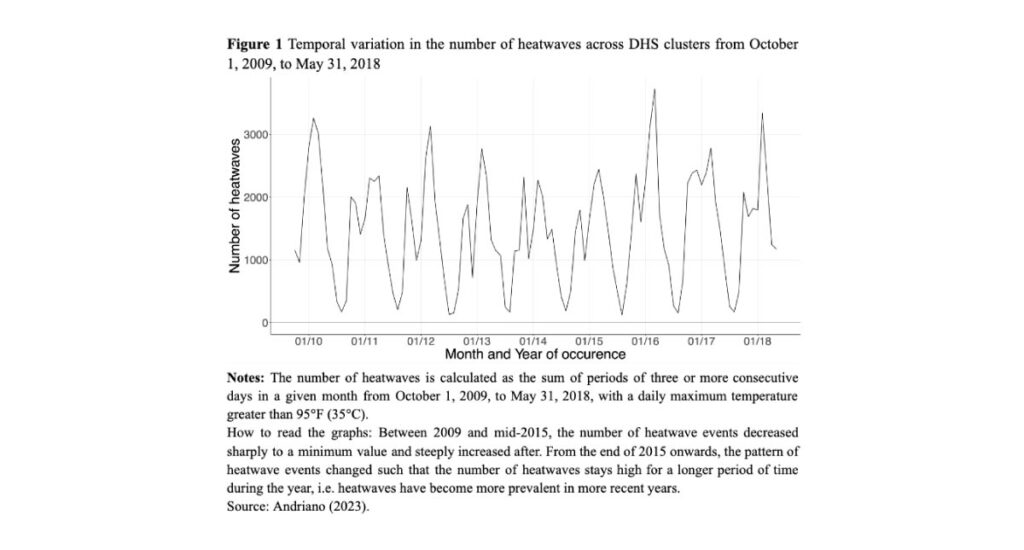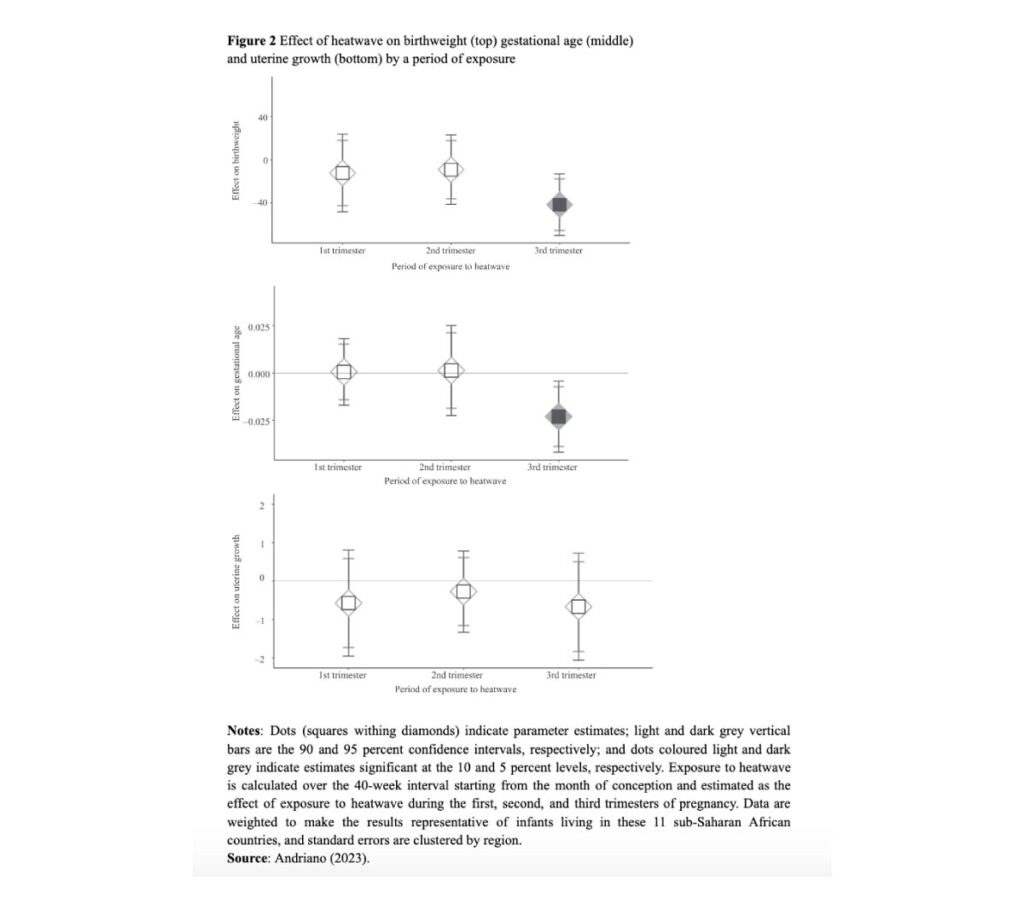Liliana Andriano shows that heatwave exposure prior to birth causes lower birthweight. Given the implications for life-long health and well-being, the study provides insights for policymakers who are concerned with mitigating the negative consequences of climate change.
Introduction
The adverse effects of climate extremes, particularly heatwaves, on health at birth are becoming a focal point of public health research. Birthweight is a crucial indicator of neonatal health and a predictor of future well-being, with low birthweight linked to higher infant mortality, as well as chronic diseases and poorer socioeconomic outcomes later in life. The relationship between birthweight and short- and long-run health and socioeconomic outcomes suggests that the heatwave effect on birthweight may have dramatic consequences for population health and well-being. These adverse consequences may be particularly severe for the poor, who are disproportionately vulnerable to heatwaves that result from global warning (IPCC 2014, 2019).
Figure 1 shows that the incidence of heatwaves in Sub-Saharan Africa has increased in recent years. They are expected to become even more frequent, more intense, and longer in years to come (IPCC 2014, 2019), with adverse effects on global health and socioeconomic inequalities.

In a recent study (Andriano 2023), I investigated the relationship between exposure to heatwaves and birthweight by analysing both the timing of heatwave exposure in utero and the mechanisms through which it may affect birthweight.
Data
I combined datasets from two sources: (1) georeferenced microlevel data from the Demographic and Health Surveys (DHS) and (2) georeferenced climate data from the ERA5 archive provided by the European Centre for Medium-Term Weather Forecasting (ECMWF).
The DHS surveys are national household surveys conducted in low- and middle-income countries: the countries/years that I analyzed are Angola (2015), Benin (2017), Burundi (2016), Ethiopia (2016), Malawi (2015), Mali (2018), Nigeria (2018), South Africa (2016), Uganda (2016), Zambia (2018), and Zimbabwe (2015).
DHS data are particularly suitable for this study for two main reasons. First, they include information on the GPS latitude and longitude coordinates of the communities of residence, which allowed me to link interviewed women (and their children) to their geographic location at the time of survey and infer the climatic conditions they were exposed to during pregnancy. Second, DHS surveys provide information on the date of birth and the duration of pregnancy for all births, making it possible to create measures of gestational age at birth and intrauterine growth, through which heatwave effects can be identified. Additional information (child’s sex and mother’s socioeconomic characteristics) is also available.
The climate dataset retrieved from the ECMWF’s ERA5 archive contains data for every hour since January 1, 1979, on a global grid of parallels and meridians at a 0.25×0.25-degree resolution — about 30 km at the equator. I used data on maximum air temperature to calculate heatwave exposure during each trimester of gestation, constructed as 1–12 weeks after conception for the first trimester, 13–26 weeks after conception for the second, and 27–40 weeks after conception for the third.
A trimester of gestation is identified as exposed to (one or more) heatwaves if the daily maximum temperature exceeds 95°F (35°C) for three or more consecutive days.
The effect of in-utero exposure to heatwave on birthweight: timing and mechanisms
Infants exposed to heatwave in the third trimester of gestation have significantly lower birthweight (Figure 2), with a mean reduction of 41.8 grams, but uterine growth is not significantly affected. In other words, the reduction in birthweight is primarily mediated by an increased probability of preterm birth, rather than intrauterine growth restriction; heatwave-induced stress triggers the production of hormones related to premature delivery and low birthweight.

Not all babies are affected in the same way
The study also highlights differential vulnerabilities, showing that the effect of heatwaves is concentrated among male infants and mothers with no or little formal education. This suggests that educational attainment can play a protective role against heat-related health impacts. The effect of in-utero exposure to heatwaves may be concentrated among males due to several biological and physiological factors. For example, male foetuses grow more rapidly, making them more vulnerable to heat stress. Their higher metabolic demands and oxygen levels can be more adversely affected by heatwave-induced stress, leading to greater developmental impacts.
Conclusion
Overall, these results are relevant to practitioners and policymakers who design policies to reduce the negative impacts of climate change. First, these findings urge us to consider conditions prior to birth as potential drivers for health and socioeconomic inequalities after birth. Second, it is crucial to invest in maternal education to enhance women’s abilities to mitigate the consequences of exposure to heatwaves during pregnancy, especially considering that climate extremes will likely increase in the coming decades.
References
Andriano, L. 2023. On the Health Impacts of Climatic Shocks: How Heatwaves Reduce Birthweight in Sub‐Saharan Africa. Population and Development Review, 49(4), 737-769.
IPCC. 2014. Climate Change 2014: Impacts, Adaptation, and Vulnerability. Part B: Regional Aspects. Contribution of Working Group II to the Fifth Assessment Report of the Intergovernmental Panel on Climate Change. Edited by V.R. Barros, C.B. Field, D.J. Dokken, M.D. Mastrandrea, K.J. Mach, T.E. Bilir, M. Chatterjee., et al. Cambridge: Cambridge University Press.IPCC. 2019.
Climate Change and Land: An IPCC Special Report on Climate Change, Desertification, Land Degradation, Sustainable Land Management, Food Security, and Greenhouse Gas Fluxes in Terrestrial Ecosystems. Edited by P.R. Shukla, V. Masson-Delmotte, J. Skea, E. Calvo Buendia, J. Petzold, H.-O. Pörtner, D. C. Roberts, P. Zhai, R. Slade, S. Connors, R. Diemen, M. Ferrat, E. Haughey, S. Luz, S. Neogi, M. Pathak, J. Malley, J. Portugal Pereira, P. Vyas, E. Huntley, K. Kissick, M. Belkacemi. Geneva, Switzerland: Intergovernmental Panel on Climate Change.


